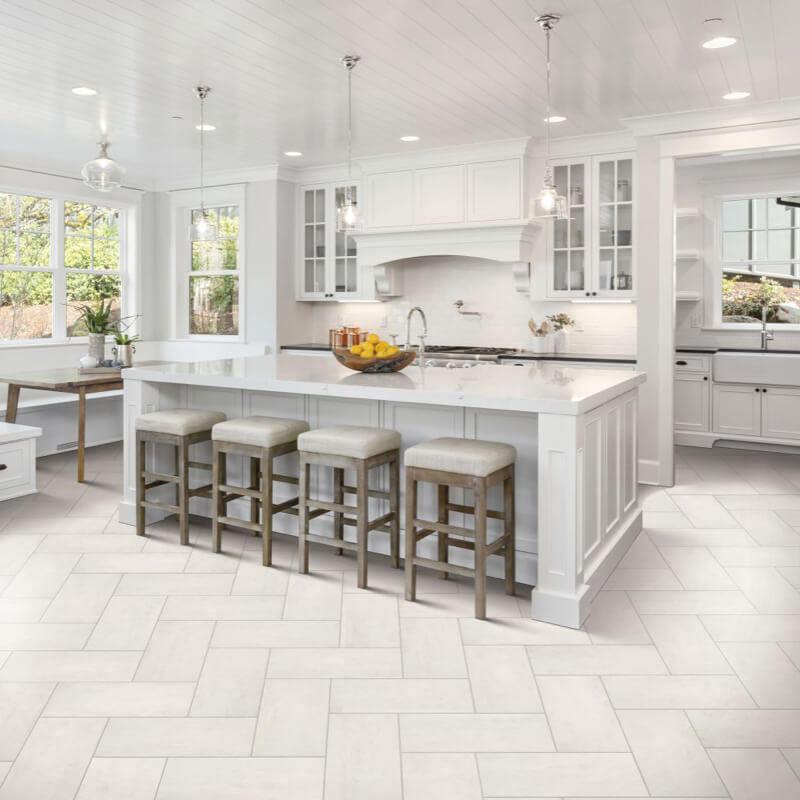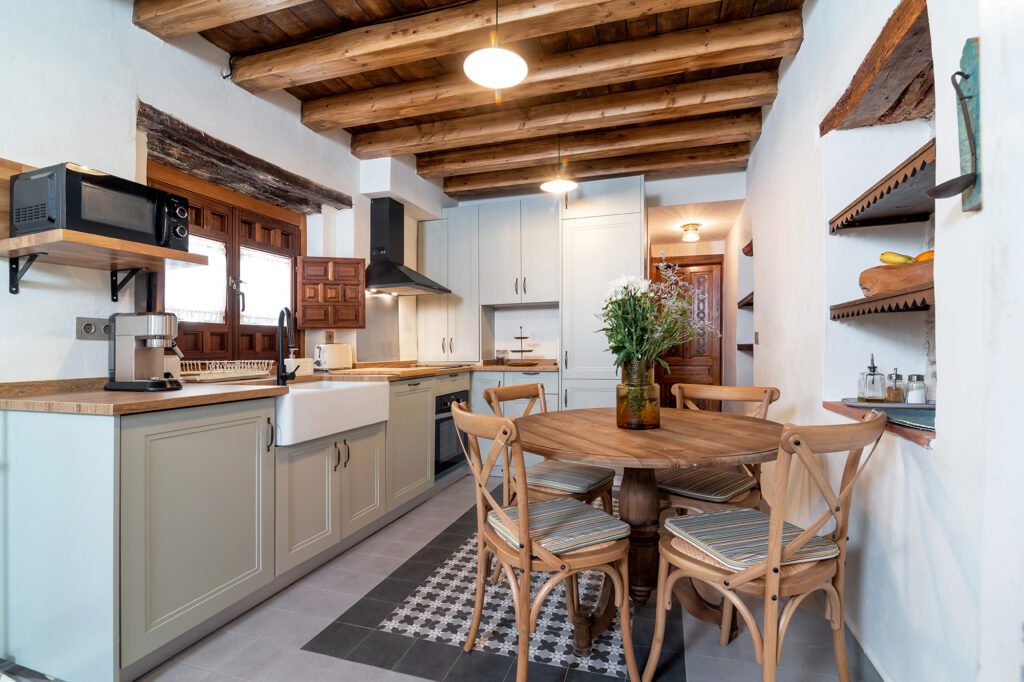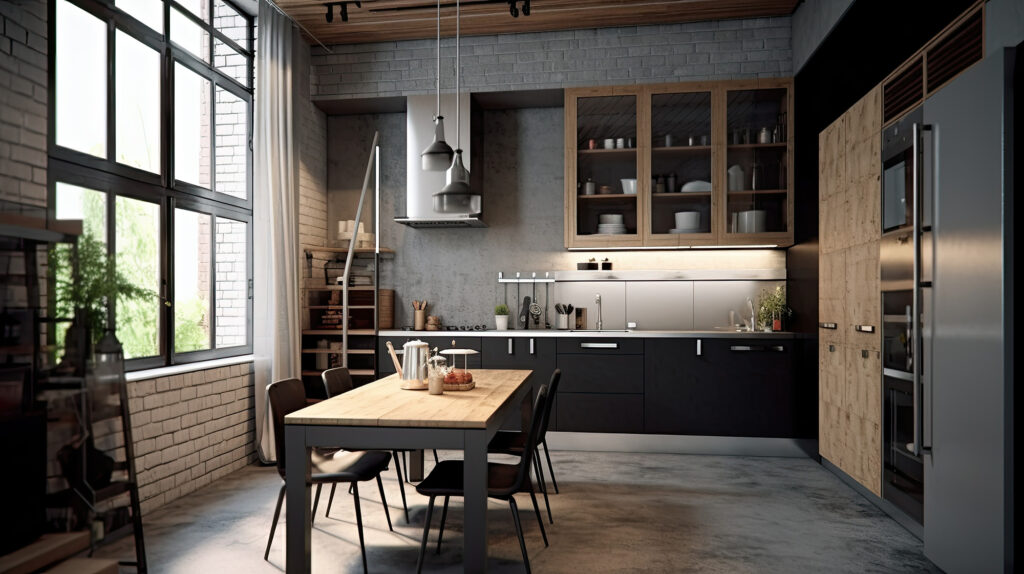Ceramic vs. Porcelain Tile: Which Is Better for Your Kitchen Remodel?
Your kitchen is the heart of your home, where your family gathers, meals are shared, and memories are made.
But with all that activity comes spills, high foot traffic, and daily wear and tear. Choosing the right tile for your kitchen remodel is crucial, as it needs to withstand these challenges while also looking beautiful.

Both ceramic and porcelain tile offer a durable, resistant surface, but they have key differences that make them suitable for different needs. The one you choose will be a balance of your personal preference, your lifestyle needs, and your budget.
What’s the Difference Between Ceramic and Porcelain Tile?
The fundamental difference in ceramic and porcelain tiles lies in their composition and manufacturing process. Ceramic tile is typically made from clay and other materials, fired at a lower temperature. Porcelain tile, on the other hand, uses finer clays and is fired at a much higher temperature, resulting in a denser, less porous tile. This density difference directly impacts their durability, water resistance, and overall performance.
Porcelain tile has a very low water absorption rate (often less than 0.5%), meaning it’s highly resistant to moisture and stains. Ceramic tile has a higher absorption rate, making it more susceptible to these issues if not properly sealed.

Is Ceramic or Porcelain Tile More Durable?
Because porcelain is fired at a higher temperature, it becomes denser and stronger. This translates to increased resistance to scratches, chips, and general wear and tear, making it an excellent choice for high-traffic kitchen floors. Ceramic is still durable, but it’s more prone to wear over time compared to porcelain.
Is Ceramic or Porcelain Tile More Affordable?
If you’re looking for a budget-friendly option, ceramic tile is typically more affordable upfront. However, porcelain tile offers excellent value in the long run thanks to its superior durability and longevity. Its resistance to wear and tear can mean less need for repairs or replacement over time.
Is Ceramic or Porcelain Easier to Maintain?
Both ceramic and porcelain tile are relatively easy to maintain. Regular cleaning with appropriate cleaners is essential for both. Sealing the grout, especially for ceramic tile, is important to prevent staining and water damage. Because porcelain is less porous, it inherently resists stains better and may require less frequent sealing of the grout.
What are the Pros and Cons of Using Ceramic Tile in My Kitchen?
Ceramic tile remains a popular choice for kitchen renovations, and for good reason. It offers a wide range of design possibilities and can be a cost-effective option. However, it’s important to weigh its advantages against its limitations, especially in a high-traffic, moisture-prone space like a kitchen.
Pros:
- Versatile Design: Ceramic tile comes in an incredible array of styles, colors, patterns, and sizes, allowing you to create almost any look you desire.
- Budget-Friendly: Ceramic tile is generally more affordable than porcelain, making it a good choice for those with budget constraints.
- Lighter Weight: Ceramic tiles are typically lighter than porcelain, which can make them easier to handle and install, especially for DIY projects.
- Suitable for Certain Applications: Ceramic tile can be a great choice for backsplashes and wall applications in the kitchen, where its lower durability and higher water absorption are less of a concern.
Cons:
- Higher Water Absorption: Ceramic tile’s higher water absorption rate makes it more susceptible to staining and moisture damage, especially in areas prone to spills. This makes sealing crucial.
- Less Durable: Compared to porcelain, ceramic tile is more prone to chipping, scratching, and cracking, particularly in high-traffic areas like kitchen floors.
- Requires More Maintenance: Due to its porosity, ceramic tile grout may need more frequent sealing to protect it from stains and moisture.
What are the Pros and Cons of Using Porcelain Tiles in My Kitchen?
Porcelain tile has become a top choice for kitchen renovations thanks to its exceptional durability and resistance to moisture. While it comes with a higher price tag than ceramic, its performance benefits often make it a worthwhile investment.
Pros:
- Exceptional Durability: Porcelain tile’s density and high firing temperature make it incredibly resistant to scratches, chips, and general wear and tear. It can withstand the rigors of a busy kitchen.
- Superior Water Resistance: With a very low water absorption rate, porcelain tile is highly resistant to stains, moisture damage, and spills, making it ideal for kitchen environments.
- Versatile Applications: Porcelain tile’s strength and water resistance make it suitable for a wide range of kitchen applications, including high-traffic floors, backsplashes, and even countertops (with careful consideration).
- Low Maintenance: Porcelain tile requires minimal maintenance. Its low porosity means it resists stains well, and the grout may not need sealing as frequently as with ceramic tile.
- Design Flexibility: Porcelain tile is available in a wide variety of styles, colors, and patterns, mimicking natural stone or other materials, giving you design flexibility.
Cons:
- Higher Cost: Porcelain tile is generally more expensive than ceramic tile, both in terms of material costs and potential installation costs due to its density.
- Challenging Installation: Porcelain’s density means it requires specialized tools for cutting and installation, which can add to labor costs.
- Can Be Cold: Like other tile materials, porcelain can feel cold underfoot.
- Less Variety in Textured Finishes: While porcelain tile offers a wide range of looks, the variety of highly textured or rustic finishes may be less than with ceramic.
How Do I Choose the Right Tile for My Project?
Choosing the right tile for your kitchen remodel involves balancing several factors, from the practical considerations of application and lifestyle to the more personal aspects of style and budget. There’s no one-size-fits-all answer, so it’s essential to consider your individual needs and priorities.

- Application: Where will the tile be used? Backsplashes, walls, and low-traffic areas can often use ceramic tile effectively. High-traffic kitchen floors, especially in busy households, generally benefit from the durability and water resistance of porcelain. Consider whether the tile will be exposed to heat (near the stove), moisture (around the sink), or heavy foot traffic.
- Lifestyle: How do you use your kitchen? If you’re a busy family with kids and pets, spills and messes are inevitable, making porcelain’s stain resistance a valuable asset. If you’re a less frequent cook, ceramic tile might be sufficient for your needs. Think about your cleaning habits too – porcelain’s easy maintenance can be a plus for busy individuals.
- Style: What aesthetic are you trying to achieve? Both ceramic and porcelain tile offer a wide range of styles, from classic to contemporary. Consider the overall design of your kitchen and choose tiles that complement your cabinets, countertops, and appliances. Don’t forget the impact of grout color too!
- Budget: Ceramic tile is generally more budget-friendly upfront. However, porcelain’s longevity and reduced need for repairs or replacement can make it a cost-effective choice in the long run. Balance your initial budget with the potential long-term value and durability of each material.
Making the Best Choice for Your Kitchen
Choosing between ceramic and porcelain tile for your kitchen remodel is a significant decision. Both materials offer distinct advantages and disadvantages. By carefully considering the specific needs of your kitchen – from the demands of the space itself to your personal lifestyle and design preferences – you can select the tile that best suits your project.
Visit Classic Flooring Center, and let’s find the right fit for your kitchen remodel!
